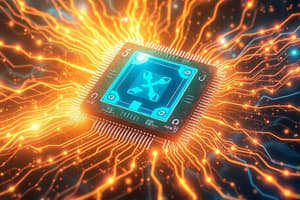Podcast
Questions and Answers
What is the relationship between resistivity and conductivity of a material?
What is the relationship between resistivity and conductivity of a material?
- Conductivity is inversely proportional to resistivity (correct)
- Conductivity is equal to resistivity
- Conductivity is independent of resistivity
- Conductivity is directly proportional to resistivity
What is the main factor that determines the conductivity of an electrolyte?
What is the main factor that determines the conductivity of an electrolyte?
- Geometry of the electrolyte
- Temperature (correct)
- Impurities
- Sample size
What is the term for the flow of electrically charged particles in response to an applied electric field?
What is the term for the flow of electrically charged particles in response to an applied electric field?
- Electrical conduction (correct)
- Electrostatic attraction
- Electromagnetic induction
- Electromagnetic radiation
Which of the following materials has zero resistance at a certain temperature?
Which of the following materials has zero resistance at a certain temperature?
What is the effect of deformation on the conductivity of metals?
What is the effect of deformation on the conductivity of metals?
What is the term for the voltage divided by the current in a material?
What is the term for the voltage divided by the current in a material?
What is the approximate conductivity of silver at room temperature in Siemens per meter?
What is the approximate conductivity of silver at room temperature in Siemens per meter?
What type of semiconductor is formed when a phosphorus atom is added to silicon?
What type of semiconductor is formed when a phosphorus atom is added to silicon?
What happens to the conductivity of a doped semiconductor at very low temperatures (T < 100 K)?
What happens to the conductivity of a doped semiconductor at very low temperatures (T < 100 K)?
What is the effect of doping on the conductivity of silicon?
What is the effect of doping on the conductivity of silicon?
What type of impurity is zinc when added to the compound semiconductor GaAs?
What type of impurity is zinc when added to the compound semiconductor GaAs?
At what temperature range is the conductivity of a doped semiconductor considered 'extrinsic'?
At what temperature range is the conductivity of a doped semiconductor considered 'extrinsic'?
What is the primary function of a p-n rectifying junction diode?
What is the primary function of a p-n rectifying junction diode?
What happens when a p-n junction is forward biased?
What happens when a p-n junction is forward biased?
What is the primary mechanism of charge carrier movement in thick solar cells?
What is the primary mechanism of charge carrier movement in thick solar cells?
What type of semiconductor material is used for the p-type region in a p-n junction?
What type of semiconductor material is used for the p-type region in a p-n junction?
What is the result of light exciting electrons in a solar panel?
What is the result of light exciting electrons in a solar panel?
What is an example of an application of p-n junctions?
What is an example of an application of p-n junctions?
Flashcards are hidden until you start studying
Study Notes
Resistivity and Conductivity
- Resistivity and conductivity are inversely related; high resistivity indicates low conductivity and vice versa.
- Conductivity is primarily determined by charge carriers' concentration and mobility.
Conductivity of Electrolytes
- The main factor influencing electrolyte conductivity is the presence and concentration of ions.
Charge Flow
- The flow of electrically charged particles in response to an applied electric field is known as current.
Zero Resistance Material
- Certain materials exhibit zero resistance at specific temperatures, a phenomenon known as superconductivity.
Effect of Deformation on Metals
- Deformation in metals typically results in increased resistivity and reduced conductivity due to dislocation movement.
Voltage and Current Relationship
- The term for voltage divided by current in a material is resistance.
Conductivity of Silver
- The approximate conductivity of silver at room temperature is around 63 x 10^6 Siemens per meter.
Semiconductor Type from Doping
- Adding phosphorus to silicon forms an n-type semiconductor, characterized by excess electrons.
Conductivity at Low Temperatures
- The conductivity of a doped semiconductor decreases significantly at temperatures below 100 K, approaching that of an intrinsic semiconductor.
Effect of Doping on Silicon
- Doping silicon increases its conductivity by introducing additional charge carriers (electrons or holes).
Zinc as an Impurity
- When zinc is added to the compound semiconductor GaAs, it acts as a p-type dopant.
Extrinsic Conductivity Range
- A doped semiconductor exhibits extrinsic conductivity typically in the temperature range of 200 K to 400 K.
Function of p-n Junction Diode
- The primary function of a p-n rectifying junction diode is to allow current to flow in one direction while blocking it in the reverse direction.
Forward Bias in p-n Junction
- When a p-n junction is forward biased, charge carriers are injected into the depletion region, allowing current to flow.
Charge Carrier Movement in Solar Cells
- In thick solar cells, the primary mechanism of charge carrier movement is diffusion.
p-Type Region Material
- The material used for the p-type region in a p-n junction is typically doped with elements like boron.
Light Excitation in Solar Panels
- When light excites electrons in a solar panel, it generates electron-hole pairs, contributing to current flow.
p-n Junction Applications
- p-n junctions are widely used in various applications, including diodes, transistors, and photovoltaic cells.
Studying That Suits You
Use AI to generate personalized quizzes and flashcards to suit your learning preferences.




